When: 28 November – 15 December 2013
Where: Shanghai Dramatic Arts Center
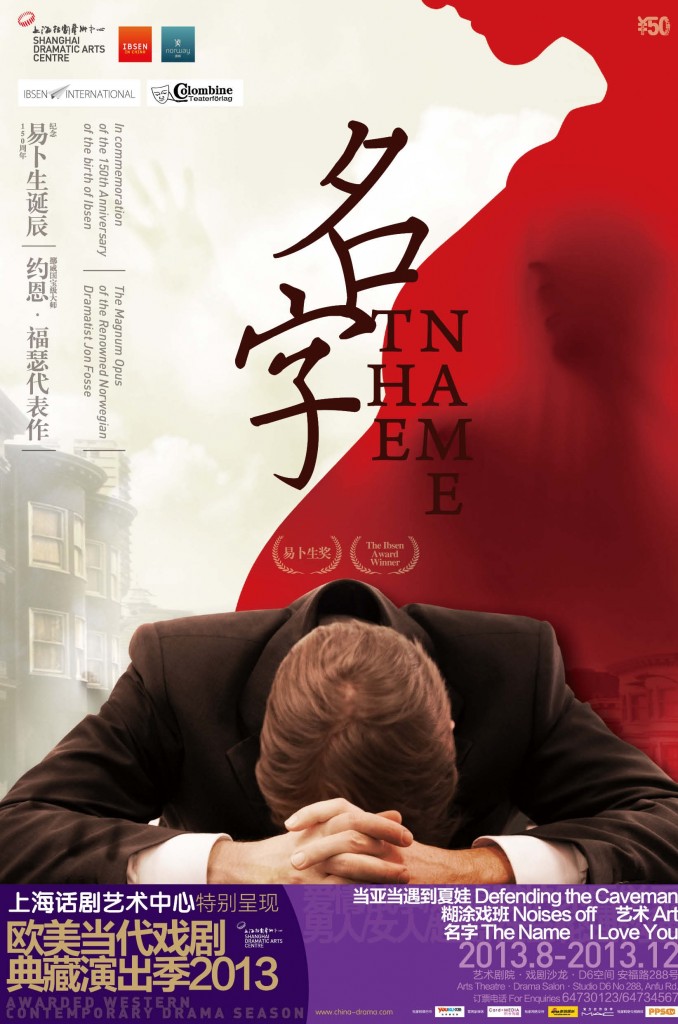
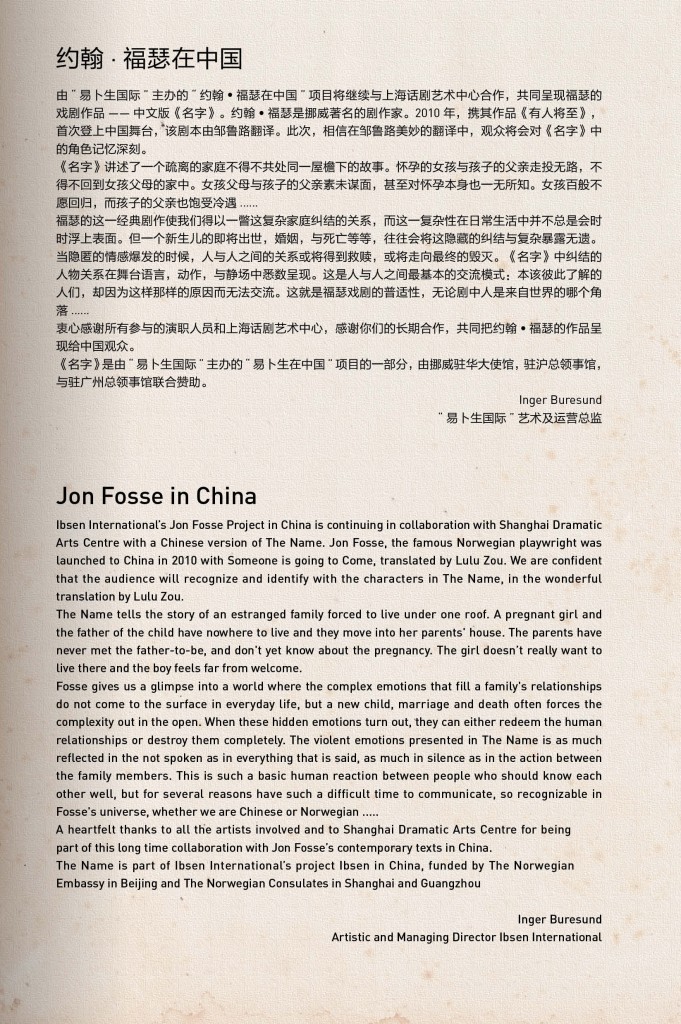
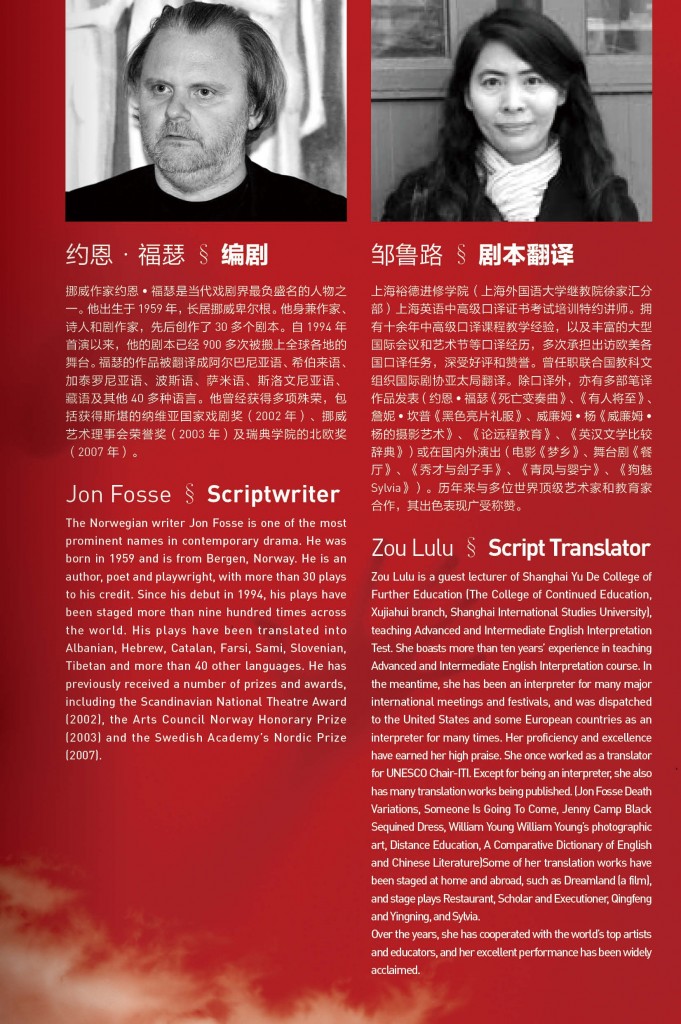
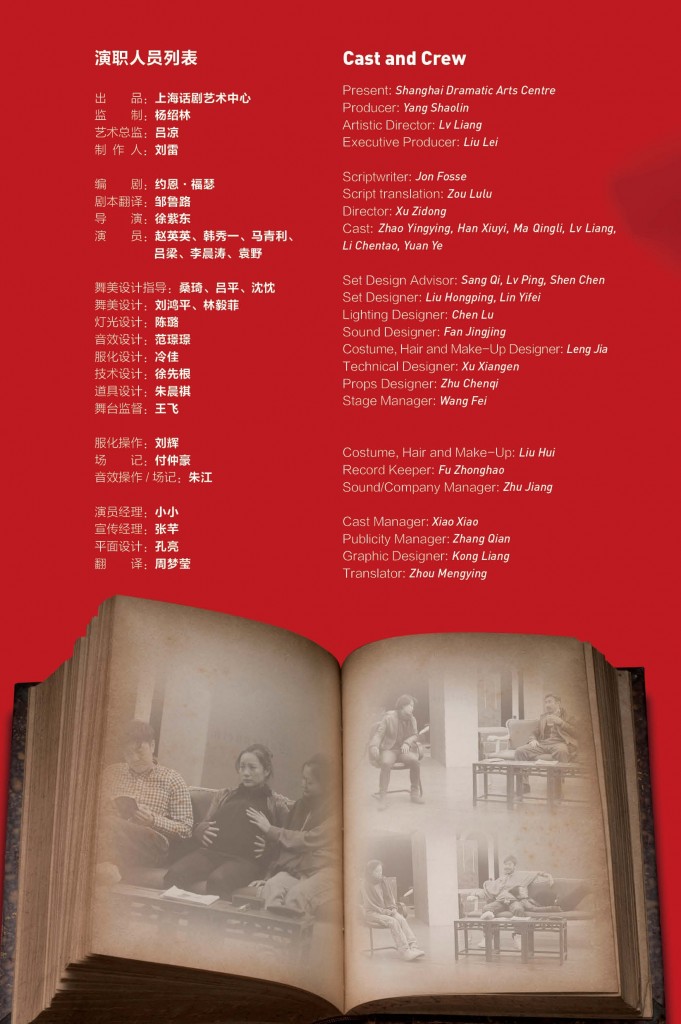
Commissioned by Ibsen International for the project Ibsen in China 2013. Produced by Phoenix Conceptual Theater (Norway) in co-operation with Simon Abbe Dance Company (China/Cameroon).
Beijing Moderne Dance Festival (premiere): Star Theatre, 26 July 2013, 2 p.m. & 4 p.m.
Choreography and dance: Jiang ke-yu, Henriette Blakstad and Simon Abbe
Costumes: Henriette Blakstad
Sound design and video: Jiang ke-yu
Light design: Low Shee Hoe
Text and set-design: Mariann Rostad
Henriette Blakstad and Jiang Ke-ju choreographed the devised dance piece “RETURN” for the Guangdong Dance Festival 2012. Due to the great success of the performance, the Artistic Director of the festival Willy Tsao suggested to extend the project and to present a new piece for the Beijing Dance Festival 2013. For the occasion, Simon Abbe joined the team and, together with Henriette and Ke-ju, created “CARCASS” as the second part of a trilogy.
CARCASS
Wounded hope from a narrow steel breath
a flame of infinite direction but yet so distant
The dark embalms the whole world
just not at the same time
we are not so different you and me
no breath but still air
no life but still alive
in between
The earth eats, life grasps
feeds itself from what ones was
and maybe still is
digs into the flesh, no respect
If I somehow could tell you that dark is dark and blood is blood
the beat of a heart stops in the same way
Listen
Mariann Rostad

ABOUT PHOENIX CONCEPTUAL LAB
Phoenix Conceptual Theater is a professional theater ensemble founded in 2008 based in Oslo (Norway). The Company is directed by Henriette Blakstad and Mariann Rostad. Phoenix CT is a not-for-profit, independent devised theater group. Their concepts are highly visual, based on movement and the use of space, text, dramaturgy and music. Regardless of the ‘genre’ of their pieces, the group’s work is influenced by the human body, far-out visual fantasy, fragmented narratives and intense acting and movement-performances. The two latest performances by Phoenix CT have done are co-produced with the Chinese choreographer Jiang ke-yu and Simon Abbe Dance Company. Together they developed “Return” (2012) and “Carcass”(2013), two devised dance-pieces that performed on the international dance festivals Contact 2012 (Singapore), Guangzhou Modern Dance Festival 2012 (China) and Beijing Dance Festival 2013.
FUTURE PLANS: a new devised theater piece, an adaption of “Hedda Gabler” by Henrik Ibsen intertwined with “Orlando” by Virginia Woolf, a co-production between Phoenix CT and the young and talented director Mei Ann Theo (New York/Singapore), just graduated from the highly acclaimed directing program at Columbia University in New York (USA).
BIOGRAPHIES
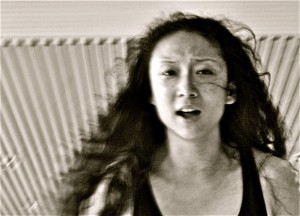 JIANG Ke-yu, founding member of “Na’er Dance Company”. Ke-yu graduated in 2004 from the Beijing Dance Academy, majoring in Choreography of Contemporary Dance. Between 2005 and 2009 she was invited by the Chinese Ministry of Culture to work as choreographer and dance instructor for the Cameroon National Dance (Cameroon). Jiang choreographed several opening ceremonies as well as various large-scale productions both in China and abroad, including her most recent work Chinese Calligraphy Music and Dance Concert (August 2012, Sadler’s Well, London). She has participated many times to the Beijing Dance Festival and the Guangdong Dance Festival.
JIANG Ke-yu, founding member of “Na’er Dance Company”. Ke-yu graduated in 2004 from the Beijing Dance Academy, majoring in Choreography of Contemporary Dance. Between 2005 and 2009 she was invited by the Chinese Ministry of Culture to work as choreographer and dance instructor for the Cameroon National Dance (Cameroon). Jiang choreographed several opening ceremonies as well as various large-scale productions both in China and abroad, including her most recent work Chinese Calligraphy Music and Dance Concert (August 2012, Sadler’s Well, London). She has participated many times to the Beijing Dance Festival and the Guangdong Dance Festival.
 Henriette BLAKSTAD,
Henriette BLAKSTAD,
Artistic and Managing Director Phoenix Conceptual Theater. In 1992 Henriette graduated with a BA in classical ballet, contemporary and jazz dance from the Oslo National Academy of the Arts, and continiued her studies at the Norwegian Academy of Acting. Her 23 years’ long career as a professional performer begins at The Norwegian National Ballet in classic pieces such as Swanlake, Don Quixotte and Romeo and Juliet. Aftwerwards she performed in several musicals such as A Chorus Line, where she sung the leading part, and moved to modern dance working with several outstanding Norwegian choreographers like Sølvie Edvardsen and Un-Magritt Norseth that brought her to China to perform Henrik Ibsen’s “A Dolls Hose” in co-production with Jin Xing Dance Theater (commissioned by Norwegian National Ibsen Theater and produced by Inger Buresund).
Blakstad’s work as a director and choreographer have received increasing attention since 2008. Her many pieces include “Return”in co-production with choreographer Jiang ke-yu (Guangzhou Modern Dance Festival in China and Contact 2012 in Singapore), “The Mobile Lady”, “The Invisible”, “As you like it Whatever happened to Beauty?” (Skidmore College, New York) and “Dust” (Norwegian National Ballet School). Blakstad has currently opened her own studio space “STUDIO 18” in Oslo, that houses her company Phoenix CT, and offers physical acting training for professionals in co-operation with The Norwegian Acting Center. This fall she will perform in “Doris Lessing”, a new written devised piece for adults involving puppetry.
 Simon Romuald Abbe starts his career as a hip-hop dances in Cameroon in 1998. His group ” Black Star” wins the Cameroon urban dance competition four times. Afterwards he attends a 3 years training in classical and contemporary dance at the National Ballet of Cameroon under the direction of Chinese choreographers and instructors Naersi and Jiang keyu. During this time he created his first choreographies and in 2008 founds his company ” Simon Abbe” in Yaounde, Cameroon.
Simon Romuald Abbe starts his career as a hip-hop dances in Cameroon in 1998. His group ” Black Star” wins the Cameroon urban dance competition four times. Afterwards he attends a 3 years training in classical and contemporary dance at the National Ballet of Cameroon under the direction of Chinese choreographers and instructors Naersi and Jiang keyu. During this time he created his first choreographies and in 2008 founds his company ” Simon Abbe” in Yaounde, Cameroon.
Since 2009 Simon Abbe company works between Cameroon and China. Its foundations are traditional and contemporary dance, hip hop and martial arts techniques such as taijiquan and qi gong. The company focuses on an exploration of the body in its various forms and its vastness. The company collaborates with dance groupes in Cameroon, Norway ,China and France. Simon Romuald Abbe’s coreographies have been performed in several festivals and events including the Football World Cup, African Cup, Olympic games and The Pan-African Festival.
 Mariann Rostad As the second half of Phoenix Conceptual Theater, Mariann Rostad contributes with her expertise within set-design and composition of text-material/new written text.
Mariann Rostad As the second half of Phoenix Conceptual Theater, Mariann Rostad contributes with her expertise within set-design and composition of text-material/new written text.
Mariann is educated from Einar Granum Artschool, Wood and Metal Art-College, and Production Design at The Norwegian Film School. She has been working for several of the biggest theaters in Norway, like Riksteatret, Nordland Theater, NRK -The Norwegian National Broadcasting, Mariann is now engaged at The Norwegian Theatre in Oslo, Norway in addition to working with Phoenix CT.
PERFORMANCE PICTURES:






Concept: Inger Buresund, Hege Randi Tørressen
Project management: Fabrizio Massini
Dramaturges: Hege Randi Tørressen, Bodil Kvamme
Guest lecturers: Qu Shifei, Shao Zehui
Playwrights: Oda Fiskum, Liu Yinshi, Marco Demian Vitanza, Zhao Xun
Actors: Dong Ziyi, He Yang, Wu Genghua, Yi Hang, Yu Yang, Wang Xiaodi
Interpreters: Li Yuan, Fabrizio Massini
Translators: Zhang Qiong (EN-ZH), Fabrizio Massini (ZH-EN)
OVERVIEW:
The workshop for playwrights “New texts, new stage” took place in Beijing from the 16th until the 20th of April 2013. Four young playwrights (two from China and two from Norway) were invited to take part in the workshop. The selected playwrights are Zhao Xun, Yinshi, Oda Fiskum and Marco Demian Vitanza.
All the four writers were required to submit one of their works which they would like to work on. The fours texts were firstly translated (the Chinese scripts into English and vice-versa) and then emailed to all the participants involved in the workshop, so that everybody could do some preliminary work before the first meeting in Beijing. After a first plenary session, the participants were divided into two groups consisting of one Chinese and one Norwegian writer. Two experienced dramaturges, Hege Randi Tørressen and Bodil Kvamme, lead one group each, assisted by professional interpreters with experience in theatre practice to overcome the language barrier.
DAY1: On the first day all the texts were read aloud by the six actors of the National Theatre of China’s troupe. The actors were also asked to give their views on the plays.
DAY 2 – 4: During the following three days, the playwrights were asked to deliver five pages of new material each day. The new material had to be sent for translation by 7 PM, so that the two translators could send the translation back within the night and allow the two dramaturges to prepare the next morning’s session. The actors joined the groups also on day 3 to read aloud the new material and provide their personal feedback.
Besides the sessions dedicated to script-writing, the workshop also included a series of lectures. Ibsen International’s dramaturge Hege Randi Tørressen gave a lecture on “Dramaturgy from a Western Perspective”; Qu Shifei, professor of dramatic literature at the Central Academy od Drama of Beijing, gave a lecture on “Chinese Drama”; Shao Zehui, Chinese theatre director, gave a lecture about his work with the Beijing Fringe Festival.
DAY 5: On the fifth day of the workshop a group of guests were invited to attend a reading consisting of selected excerpts from the four scripts. Afterwards, there was a Q&A session about the workshop, its participants and the four texts.
OUTCOME: This has been an enriching and challenging experience for everybody involved in the workshop. Through a substantial daily workload, strict deadlines, continuous discussions and exchange with the other participants, the four playwrights were pushed to explore different possibilities, to develop their text along different lines.
NEXT STEPS OF THE PROJECT:
The playwrights will work autonomously on their scripts for the next six months. In November 2013, during SESSION 2, they will gather again in Beijing for a further revision and reworking of the drafts. The final drafts will be handed in by the spring of 2014 and used as the departure point for a WORKSHOP ON DIRECTION, with the final objective being the staging of full-lenght plays in 2015.
FEEDBACK FROM THE PARTICIPANTS:
Bodil Kvamme, Norwegian dramaturge:
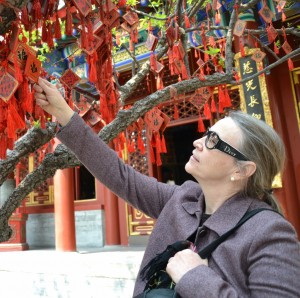 “I mentored two playwrights, Marco Demian Vitanza and Zhao Xun. I had never met either of them, and it was also my first encounter with their writing and working method. It was fantastic to meet two writers with such different backgrounds and personal experiences. I think the workshop has been at the same time a challenge and an occasion of professional growth for both of them. The conversations between the two of them have been instructive and hopefully will gave them a new insight in their own writing. I have met two writers who were very attentive, creative, proactive and open for input!”
“I mentored two playwrights, Marco Demian Vitanza and Zhao Xun. I had never met either of them, and it was also my first encounter with their writing and working method. It was fantastic to meet two writers with such different backgrounds and personal experiences. I think the workshop has been at the same time a challenge and an occasion of professional growth for both of them. The conversations between the two of them have been instructive and hopefully will gave them a new insight in their own writing. I have met two writers who were very attentive, creative, proactive and open for input!”
Liu Yinshi, Chinse playwright:
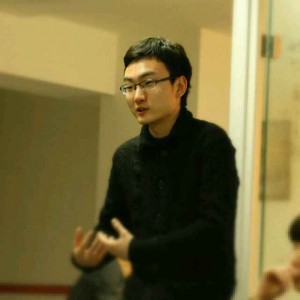 “In such a short time, I have obtained much from Ibsen International’s workshop.
“In such a short time, I have obtained much from Ibsen International’s workshop.
Firstly, the approach of this workshop is different from the traditional script-writing methods adopted in China, that is, a playwright in his own room, writing a piece on his own, maybe exchanging ideas and suggestions with other playwrights only. Conversely, in this workshop the actors were there from the very beginning and during the whole process. Having the actors reading the text aloud during the writing process, bringing up their suggestions and personal impressions, helped us to make the scripts ‘ready to be staged’ from the offset.
This workshop was very intense, it put us under a lot of pressure but also gave us a strong motivation. Exploring the different possibilities to expand a script creates even more expectations towards the final texts that will come out of this work!”
Marco Demian Vitanza, Norwegian playwright:
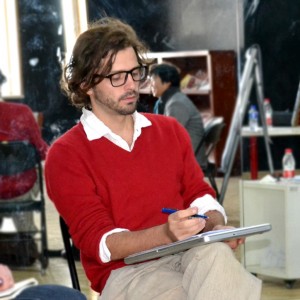 “I benefitted a lot from the workshop. I was challenged by dramaturge Bodil Kvamme to try out different ways of opening up the text, and this was both interesting and fruitful. We were asked to write five new pages each day. This didn’t fit my process every day, but it was nonetheless an interesting challenge. The feedback from Kvamme was both relevant and inspiring. I wish the workshop was longer, but I believe we got pretty far in such a short time.
“I benefitted a lot from the workshop. I was challenged by dramaturge Bodil Kvamme to try out different ways of opening up the text, and this was both interesting and fruitful. We were asked to write five new pages each day. This didn’t fit my process every day, but it was nonetheless an interesting challenge. The feedback from Kvamme was both relevant and inspiring. I wish the workshop was longer, but I believe we got pretty far in such a short time.
I learned a lot from listening to how the Chinese playwrights and actors reflect on their jobs and how they perceive Beijing. The connections between topics, aesthetics and society were strikingly present. Although there was not enough time to allow the very city of Beijing to affect my work, I believe its impressions will give impulses to my future work – especially considering China’s current role. Getting to know actors and playwrights from such a distant country was also a great pleasure, and I hope to see them again.”
Zhao Xun, Chinese playwright:
 “Firstly, from a script-writing perspective, an aspect that affected me deeply was the close work and the exchange of ideas between me and the other three playwrights. Before this experience, most of the time I write the structure and the plot of my plays on my own. The writing would follow my own way of thinking, and it would stay that way afterwards. However, working in group with playwrights from other countries and other gender (male) helped me to see the blind spots and the weaknesses in my own writing. Listening to their ideas stimulated me, shifted my train of thought towards different directions, gave me the inspiration to develop and structure my play in many different ways.”
“Firstly, from a script-writing perspective, an aspect that affected me deeply was the close work and the exchange of ideas between me and the other three playwrights. Before this experience, most of the time I write the structure and the plot of my plays on my own. The writing would follow my own way of thinking, and it would stay that way afterwards. However, working in group with playwrights from other countries and other gender (male) helped me to see the blind spots and the weaknesses in my own writing. Listening to their ideas stimulated me, shifted my train of thought towards different directions, gave me the inspiration to develop and structure my play in many different ways.”
Oda Fiskum, Norwegian playwright:
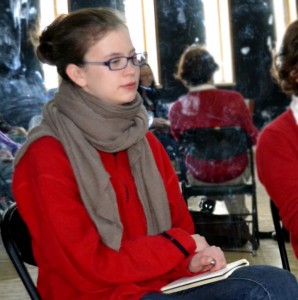 “The most unique aspect of the workshop was the opportunity to experiment with my own text within a professional context without the pressure of a production looming overhead. To be able to work with fellow writers from both China and Norway on top of this made for a new and valuable experience for me. We had complete freedom to try new approaches because the final goal was not to have a performance-ready script at the end.
“The most unique aspect of the workshop was the opportunity to experiment with my own text within a professional context without the pressure of a production looming overhead. To be able to work with fellow writers from both China and Norway on top of this made for a new and valuable experience for me. We had complete freedom to try new approaches because the final goal was not to have a performance-ready script at the end.
During the workshop I was constantly pushed forward while at the same time being able to draw inspiration from my fellow writers. Hege and the actors joined efforts in pushing me out of my comfort zone and, though it felt very uncomfortable at first, it resulted in some decent material. I have now gained a lot of new tools and possible ways forward, in my general production as well as with this particular text.
A lot of interesting conversations happened between actors, dramaturges, and the other playwrights. We argued, agreed, opened up, and gained a lot of new perspectives, both on our own and the other country’s contemporary situation. After the workshop we have all stayed in touch, kept exchanging ideas and criticism, and look forward to the next ìchapter’ ”.
PICTURES FROM THE WORKSHOP:

Premiere: 28 – 29 Jun 2013 8pm
where: Kwai Tsing Theatre Auditorium, HONG KONG
Reruns 2013: People’s Liberation Army Theatre, Beijing Dance Festival 2013, CHINA
Tour 2014:
where: Oslo Opera House (Second House), Oslo, NORWAY
when:
14.8.2014 (Thu) 7:30pm
15.8.2014 (Fri) 7:30pm
16.8.2014 (Sat) 6:30pm
tickets: Norske Opera & Ballet
Artistic Director: Willy Tsao
Choreographer: Ina Christel Johannessen
Set and Costume Designer: Kristin Torp
Lighting Designer: Goh Boon Ann
Sound Designer: Ha Yan-pui
Assistant Artistic Director: Ringo Chan
Rehearsal Assistant: Line Tørmoen
Dialogue Coach: Chan Wing-chuen
CAST
Hedvig – Jennifer Mok
Narrator – Malvina Tam
Grandpa – Dominic Wong
Father – Bruce Wong
Mother – Qiao Yang
Friend – Lai Tak-wai
Doctor – Lam Po
Ensemble Dancers – Ivan Chan, Lee Ka-ki, Peggy Lam, Shirley Lok, Evains Lui, Noel Pong
Hong Kong’s flagship City Contemporary Dance Company (CCDC) has in collaboration with Ibsen International proudly invited renowned Norwegian choreographer Ina Christel Johannessen to create a new work inspired by Henrik Ibsen’s classic, “The Wild Duck”. The choreographer reinterprets this compelling play from the perspective of the child Hedvig in collaboration with CCDC dancers and an international creative team, including the Norwegian scenographer Kristin Torp, to craft a 21st century dance classic centered on the difficulties of distinguishing truth from fiction, characterized by Ina Christel Johannessen’s high energy physicality.
The story reveals the confrontation: When the main character leads a blessed marriage with his wife and her undesirable past is later disclosed, will he choose to believe the “life-lie” or to search for the truth?
As the winner of Norwegian Critic’s Prize and Norwegian Dance Festival Oktoberdan’s Prize, Johannessen is the Artistic Director of leading Norwegian dance company Zero Visibility Corp. “HEDVIG from The Wild Duck” is her first creation in Asia, and has been commissioned by CCDC in collaboration with Ibsen International as part of Ibsen in China 2013.
INA CHRISTEL JOHANNESSEN and ZERO VISIBILITY CORP
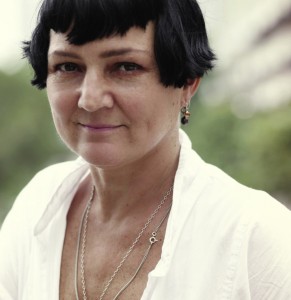
Ina has created more than 50 pieces since she started choreographing in 1988; she founded Zero Visibility Corp (ZVC) in 1996 which has become one of Norway’s leading dance companies. “…it’s only a rehearsal”, a much acclaimed piece created in 2003, took the company into the limelight in the international dance scene and has now been performed over a hundred times. In 2008, Ina was awarded the Norwegian Critic’s Prize for Ambra which elevated her stature in the performing arts even further. Ina’s dance theatre is unique, full of powerful, high-energy physicality merged with poetic and theatrical elements. Along with well-designed visuals including lighting and stage sets, her works project compelling contrasts with a surreal ambience.
CCDC – City Contemporary Dance Company
City Contemporary Dance Company (CCDC) is Hong Kong’s first full-time professional company pioneering in contemporary dance. Over the past 33 years, through the leadership of its Founder and Artistic Director, Willy Tsao, CCDC has inspired and elated audiences in Hong Kong and around the world with superb modern dance performances. Since 1979, in productions by leading choreographers such as Helen Lai, Mui Cheuk-yin, Pun Siu-fai, Yuri Ng and Tsao himself, and in innovative collaborations with the best and brightest artists from other media, this company of Hong Kong’s finest dancers has presented over 200 original works with popular and critical acclaim. CCDC’s renown in reflecting the vigour and creativity of Hong Kong’s vibrant, multi-faceted contemporary culture and astonishes 50,000 audiences annually.
Kristin Torp, set and costume designer
Kristin is working both in the field of visual art, sculpture, digital “fun”, stage design and costumes. She has been presented in several national galleries with both separate and collective exhibitions and embellishments / decorations in mission for cruise ships.
For theatre and dance she has created stage design for amongst others Den Nationale Scene (Bergen), Scirocco, Det Norske Teatret, Nationaltheatret, Den Norske Opera og Ballett (Oslo),Oldenburgisches Staatstheater (Oldenburg,Germany), Les Balletts de Monaco (Monaco), Carte Blanche (Bergen) as well as for zero visibility corp. Kristin and Ina have had a close collaboration almost since Ina started her choreographic career. Kristin’s website: www.toart.no
Performance photos:
October 11 – 13, 2012 – Rekstensamlingene, Bergen. For detailed credits please see below in the page.
Da Ponte? Who’s that?
Virtually anyone in the four corners of the earth knows Wolfgang Amadeus Mozart, the musical prodigy. Many could probably go as far humming some aria from his operas, maybe Le Nozze di Figaro or the Don Giovanni. But very few people ever heard of Mozart’s most gifted librettist, Lorenzo Da Ponte, who penned those and many other extraordinary librettos. How come? According to historian and musicologist Della Seta, once librettists were considered as important contributors to an opera as the composers. Librettos were appreciated for their literary qualities in the same ways as, say, a play by Shakespeare or Shiller, and the librettists were amongst the “pop stars” of the times, as well-known as music composers. Throughout the 1800s, however, the composer came increasingly to the fore at the expenses of their literary counterpart, who faded into oblivion. The libretto lost its status as a genre in its own right, and opera lyrics were often discredited as pompous, old-fashioned and redundant.
How can words and music serve each other?
Redressing the historical unbalance between text and music is not simply a task for music historians; it is also a crucial point to revitalize the opera genre and open up new space for development. Author and composer, lyrics and tunes, need to meet and ‘merge’ into each other. Opera Art is about how to tell a story through music and, although much and more has changed from Mozart’s times, the challenge for contemporary opera remains the same: how can words and music serve each other? In a good opera, text words and music become one, so inseparable that you cannot imagine one without the other, says Mary Miller, opera chief of Bergen National Opera. Therefore, besides reevaluating the role of the libretto and the author, a newfound collaboration between composer and author is to be sought.
Speed-dating at the Opera House?
Academia should not be limited to pure theory but also undertake practical experiments – to see what works, what does not, and why. With this approach in mind, during the three days-long program the two groups of participants (established dramatists and composers in the ‘core group’ and beginners in the ‘aspirant group’) attended master classes and discussions, while also participating to practical workshops, all under the guidance of a varied group of renown writers, composers, singers and directors. After a first all-encompassing outlook on librettos and a general discussion during the first day, the following two days were dedicated to writing sessions such as the “speed-dating” activity: composers and authors were paired up and given a drawing as a starting point. From the feelings and ideas evoked by the drawing, the couples started to exchange and challenge each other, gradually building up a story that supported a tune _ and vice versa. During the last day, all participants shared the results of the workshop with each other, the coaches and the academy leaders and, after a master class of arias led by Judith Weir and and David Harsent, the groups picked up the threads and the questions raised during the first day.
PARTICIPANTS
Core group composers: Eivind Buene, Annelies van Parys, Asbjørn Schaatun and Du Wei
Core group dramatists: Jen Hadfield, Jesper Halle, Liv Heløe and Tale Næss
Aspirant composers: Ruben Sverre Gjertsen, Sigurd Fischer Olsen, Anders Monrad and Øyvind Mæland
Aspirant dramatists: Hild Borchgrevink, Kristian S. Hæggernes, Astrid Luisa Niebuhr and Marco Demian Vitanza
Artistic leader: Michael McCarthy
Coaches: David Harsent, Lore Lixenberg, Torgeir Rebolledo Pedersen, Knut Vaage and
Judith Weir
Lecturer: Michael Baran
Singers: Lore Lixenberg, Brenden Gunnell and from KorVest: Hilde V. Hagen, Turid Moberg, Tim Lawrence and Kevin Gagnon
Pianists: André Møllerhaug and Ulrich Stærk
Premiere (2012): 28th November – 1st December, Troyan Horse Theatre, Beijing
Netherland tour (2013): 27 – 28th September, Festival de Keuze, Rotterdam
China (2013): 13th November, U13 Theater, Guangzhou; 15-16th November, Shanghai Performing Arts Centre, Shanghai.
Norway (2014): 12th Sptember, International Ibsen Festival, Oslo
Australia (2014): 16-17th September, OzAsia Festival, Adelaide
China (2015): 23-24th April, Himalayan Cultural Centre, Shanghai
Ibsen in One Take is neither a medley of Ibsen’s masterpieces nor an original pièce inspired by Ibsen’s work. It is both these things, and more.
Born of the collaboration of up-and-coming Chinese director Wang Chong and Beijing-based Norwegian playwright Oda Fiskum, Ibsen in One Take is a bold attempt to rework the Ibsenian tradition into a piece of new writing. The result is a combination of classics and novelty, a slice-of-life from a contemporary Chinese man’s existence which also reverberates with the echoes of Ibsen’s philosophical and moral dilemmas. In producer Inger Buresund’s words, a “modern Chinese story told in a contemporary yet universal way”.
Ibsen in One Take follows an old man who is spending his last days in a hospital room. As the play unfolds, the man embarks on an introspective journey into his past and reminisces about his childhood and youth, his marriage and love affairs, the turning points as well as the shortcomings in his life. Throughout this reminiscence, the man, haunted by his private ghosts, confronts his regrets and tries to make sense of his existence and unanswered questions.
The production is the result of a 6 months-long work which firstly proceeded on parallel tracks and was then assembled and reworked during rehearsals. Director Wang Chong ideated the original storyline and handed it to Fiskum, who compiled the script enriching the plot with numerous quotes and references from Ibsen’s plays (like A Doll’s House, Ghosts, Peer Gynt, Master Builder and more). The creative duo then pieced the parts together, supported throughout the process by Hege Randi Tørressen, dramaturge of Oslo’s Nationaltheatret.
A remarkably innovative trait of the pièce lies in its dramatic structure, which represents a further development of Wang ’s previous experiments with live video-recording on stage: the whole performance is filmed by a cinematic troupe who follows the actors around the stage, and projected in real time on a big screen right above the stage. Hence the performance’s name: the “one take” of the title is an actual camera take which captures the stage action from beginning to end, without any editing or montage. This dramatic device allows the audience to focus on either the stage action or its filmic rendition at will. What’s more, the free play of the two levels (stage action and film) generates an extra, self-referential layer (the filming of the stage action). The performance, in other words, is structured along different layers which continuously interact and question each other in terms of authenticity, artistic medium and emotional response.
Commissioned by Ibsen International for the project Ibsen in China 2012 in collaboration with The Norwegian Embassy in Beijing and The Norwegian Consulates General in Shanghai and Guangzhou. Produced by Théatre du Rêve Expérimental
CREDITS:
Script: Oda Fiskum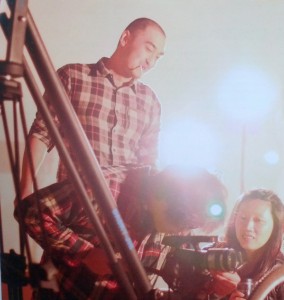
Director: Wang Chong
Assistant Directors: Liang Anzheng, Yang Fan
Director of Photography: Ding Yi
Dramaturge: Hege Randi Tørressen
Chinese Producer (2012): Li Yi
Norwegian Producer: Inger Buresund
Executive Producers: Fabrizio Massini, Liu Chen, Li Xiaoxi
Set Designer (2012): Li Yi
Set Designer (2013): Dou Hui
Costume Designer: Jin Ran
Sound Designer: Zhang Yuelong
Composer: Li Yangfan
Lighting Designer: Liu Shuchang
Stage Manager: Liu Mizhuang
Performance photos:
![]()
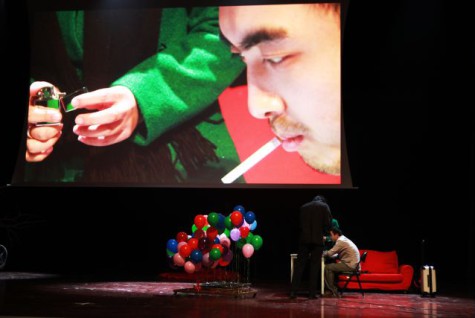
original review in Dutch posted on “Theaterkrant” _ read original
A boy lies on his back on stage. He cuts origami figures from a sheet of pink paper. A screen of white cloth separates him from his parents, who talk about him behind the screen. While acting, the actors are being filmed by a team of camera men. Their images appear live on a big screen above the stage. On the screen it seems as if the boy lies on the ground in front of his parents. The contrast between the film image and the setting on stage suggests that the talking parents only exist in the boy’s imagination.
Ibsen In One Take is the fruit of a remarkable cooperation between the Chinese theatre director Wang Chong and the Norwegian stagewright Oda Fiskum. The show enjoyed its Dutch premiere during festival De Keuze (The Choice) of the Rotterdamse Schouwburg (the city theatre of Rotterdam). Wang and Fiskum distilled characters, themes and dialogues from all of Henrik Ibsen’s 27 plays into the life story of one modern Chinese man. We see him as a little boy, as a young man and at the end of his life. Ibsen In One Take has the form of a retrospective: old, ill and weakened, the man sees his life draw past him in a series of flashbacks. The last three words of the title refer to the filmed half of the show, shot live and in one sweeping take without a single interruption, let alone any editing. Of course, they also refer to the new jigsaw puzzle Wang and Fiskum have laid out of all those hundreds of little Ibsen-pieces.
By combining film and acting Wang has doubled the space for his own imagination, and therefore also for ours. What we see on stage, continuously and simultaneously gets a different meaning on screen. Lovely is a scene early on in the play, when the man as a boy squats on the floor while his father scolds him. At first he shouts in the boy’s face. Then, suddenly, the boy changes position, but the father keeps scolding in the direction of the spot the boy has just left. On screen, however, they still seem to be looking each other in the eye. Normally it is the film director who edits separate scenes, shot at different places and times, into one fluid whole. In the scolding sequence Wang creates the separate scenes on stage – a lovely play with the laws of film and theatre.
The story of the show is of all times. The man grows up at the mercy of his father’s inability to forge an emotional bond with his son. When he receives his colleagues from work at his home, the boy is wheeled out like a circus animal, to show off his feeble mastery of the recorder. The moment they have left, his father scolds him again: ‘You know I hate the sound of that thing!’ This upbringing leads unavoidably to a failed marriage – the man cannot give what his father withheld from him. His relationship stays childless. His wife wants to leave him, but cannot bring herself to take the leap. The man ends up alone in a hospital bed, terrorised by a rude nurse. A girl with coloured balloons appears, the symbolic messenger of the nearing end of his life.
The emotional handicaps, the not-listening, the not-seeing, the indecisiveness of the characters – it is all painfully recognisable Ibsen. But with the help of his two dimensions, Wang also sculpts this material, just as recognisably, into present day China. Children who see their own way blocked by the ancient Chinese tradition that they should take care of their parents when they become old and needy. The economic necessity forcing them to work night and day, causing estrangement from their loved ones.
The ultraquick changes of clothes and position by the actors, the camera men trucking around with their equipment: next to the show itself, the simple means with which Wang has created it are constantly in full view for the audience. That gives it a vulnerable quality, stirring and touching in equal measure. Ibsen In One Take is Von Trier’s Dogville on a shoestring budget. The only uneasy aspect is the music by Zhang Yuelong. It is very beautiful, but also very loud.
The end is wonderful. The old man sees himself, and the other people he shared his life with, loom up one last time in circles of light. The moment he tries to hug them, they disappear in the darkness. White smoke envelops the stage. The circles of light merge into a path, allowing the old man to walk to his death.
Field Works is a project which explores the potential of site-specific performance and participatory art. Created by Norwegian performer Heine Avdal and Japanese artist Yukiko Shinozaki, the performance is structured in two stations (Field Works-Hotel and Field Works-Office) and was part of the Macau City Fringe Festival and Shenzhen International Fringe Festival.
Commissioned by Ibsen International (Norway) for the project Ibsen in China 2012, Macau City Fringe Festival and Shenzhen International Fringe Festival.
FIELD WORKS-HOTEL
created by: Heine Avdal & Yukiko Shinozaki
12th MACAU CITY FRINGE FESTIVAL November (China Premiere) Grandview Hotel, 17-18 November 2012
Another non-place. Inhabited and yet uninhabited. Home for a night. The television whispers to itself. Minibar. Snoring from neighbouring rooms, through flimsy walls. The pillow smells of nothing, the towels are white. Someone else will be sleeping here tomorrow.
A hotel room as a place of searching for poetry in everyday life.
In their very intimate and playful performances the Japanese artist Yukiko Shinozaki and Norwegian artist Heine Avdal create dream-like, absurd in-between worlds by means of subtle shifts in reality.
Only one visitor per performance is sucked into the mysterious past of this very ordinary hotel room: how many people have stayed here? What happened before we came in? Are we really alone, or can we hear the room breathing? Do we remain silent spectators, or will we become a character in a story?
This is an intimate performance for one spectator at the time. Duration is 20-25 min and reservation is necessary.
FIELD WORKS-OFFICE (China Premiere)
created by: Heine Avdal & Yukiko Shinozaki
Modern Media (Guangzhou Office), 22-23 November 2012
3rd Shenzhen International Fringe Festival, LOFTK company, 28-29 November 2012
3rd Shenzhen International Fringe Festival , Modern Media (Shenzhen Office), 30 November 2012
In Field Works-office, computers and photocopiers lead a life of their own, and you yourself become part of a fictitious company. In this delightful, almost surreal workshop daily office situations grow into something absurd and unusual. This is a location-based workshop, which unravels the conventions of non-theatrical spaces. In their intimate and playful performances, artists are looking for the poetry of everyday life. In this project they collaborate with sound artist Fabrice Moinet and comic artist/performer Brynjar Åbel Bandlien. Through the use of sound displacements and cartoon like drawings, bodies and actions extend beyond their borders. By small shifts in reality, they create a dreamy, absurd, in-between world, and stimulate our imagination to realise that the ordinary can be extraordinary.
After the workshop, office life will never be the same for the participants.
Performance photos:
GUANDONG DANCE FESTIVAL (premiere): 27th of November,
CONTACT FESTIVAL (Singapore): 6th December
Choreography, dance and costumes: Jiang Ke-yu and Henriette Blakstad
Light design: Low Shee Hoe
Text: Henriette Blakstad, Mariann Rostad
Commissioned by the 9th Guangdong Dance Festival and Ibsen International (Norway) for the project Ibsen in China 2012. Produced by Na´er Dance Company (China) and Phoenix Conceptual Theater (Norway).
RETURN – project what who when where why
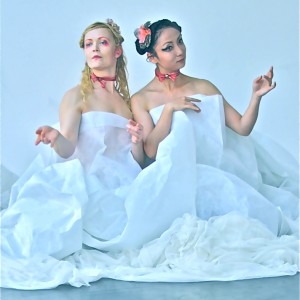
Return. A circle.
Your inner self. Your outer self.
The different faces of the woman.
What is ugly and what is beautiful?
Who decides?
Continuous repetition.
Layers we tear off to get inside.
Those innocent stories…memories.
Two feet on the ground.
Undressed and vulnerable.
Strength.
To wake up, to be awake.
Courage.
The time. Time to go near.
Time to change. Time to know.
Time to return.
BIOGRAPHIES
JIANG Ke-yu, founding member of “Na’er Dance Company”. Ke-yu graduated in 2004 from the Beijing Dance Academy, majoring in Choreography of Contemporary Dance. Between 2005 and 2009 she was invited by the Chinese Ministry of Culture to work as choreographer and dance instructor for the Cameroon National Dance (Cameroon). Jiang choreographed several opening ceremonies as well as various large-scale productions both in China and abroad, including her most recent work Chinese Calligraphy Music and Dance Concert (August 2012, Sadler’s Well, London). She has participated many times to the Beijing Dance Festival and the Guangdong Dance Festival.
Henriette BLAKSTAD
Artistic and Managing Director Phoenix Conceptual Theater. In 1992 Henriette graduated with a BA in classical ballet, contemporary and jazz dance from the Oslo National Academy of the Arts, and continiued her studies at the Norwegian Academy of Acting. Her 23 years’ long career as a professional performer begins at The Norwegian National Ballet in classic pieces such as Swanlake, Don Quixotte and Romeo and Juliet. Aftwerwards she performed in several musicals such as A Chorus Line, where she sung the leading part, and moved to modern dance working with several outstanding Norwegian choreographers like Sølvie Edvardsen and Un-Magritt Norseth that brought her to China to perform Henrik Ibsen’s “A Dolls Hose” in co-production with Jin Xing Dance Theater (commissioned by Norwegian National Ibsen Theater and produced by Inger Buresund).
Blakstad’s work as a director and choreographer have received increasing attention since 2008. Her many pieces include “Return”in co-production with choreographer Jiang ke-yu (Guangzhou Modern Dance Festival in China and Contact 2012 in Singapore), “The Mobile Lady”, “The Invisible”, “As you like it Whatever happened to Beauty?” (Skidmore College, New York) and “Dust” (Norwegian National Ballet School). Blakstad has currently opened her own studio space “STUDIO 18” in Oslo, that houses her company Phoenix CT, and offers physical acting training for professionals in co-operation with The Norwegian Acting Center. This fall she will perform in “Doris Lessing”, a new written devised piece for adults involving puppetry.
Mariann Rostad As the second half of Phoenix Conceptual Theater, Mariann Rostad contributes with her expertise within set-design and composition of text-material/new written text. She is an important part of the company, and is always involved in the artistic choices for Phoenix CT productions.
Mariann is educated from Einar Granum Artschool, Wood and Metal Art-College, and Production Design at The Norwegian Film School. She has been working for several of the biggest theaters in Norway, like Riksteatret, Nordland Theater, NRK -The Norwegian National Broadcasting, Mariann is now engaged at The Norwegian Theatre in Oslo, Norway in addition to working with Phoenix CT.
Performance photos:
Dance Workshop with Ina Christel Johannessen for LDTX Dance Company in Beijing
Ina Christel Johannessen is a Norwegian Choreographer based in Oslo. She is a graduate from the National College of Performing Arts in Oslo, where she now teaches. Johannessen has had a strong relationship with Carte Blanche, Norway’s leading modern dance company, for a long time. In addition, she is regularly involved in extensive collaborations with modern dance institutions across europe.
Furthermore, Ina functions as head choreographer and artistic director of her own company, the Zero Visibility Corp. The company had its breakthrough in 2003 with “It’s just a rehearsal”, which has been performed over 100 times. The company is highly esteemed both in Norway and internationally, and presents averagely one new production each year.
Johannessen will be conducting a workshop with Beijing-based LTDX Dance Company 13 – 25 April 2012. LDTX was founded in 2005 and has quickly built a solid reputation for quality and innovation both in China and abroad.
Ibsen Prize,1996
Fosse in China 2012
Production supervisor: Lou Wei
Executive producer: Han Sheng
Artistic supervisor: Sun Huizhu
Written by: Jon Fosse
Producer:Zhang Jun
Director: Liu Ning
Dramaturg, translator: Zou Lulu
Actors: Zhou Minghan, Lv Liang, Wang Su, Gao Yuan, Shen Lei, Ai Jiani
Stage design: Shi Hao
Lighting design: Li Hongye
Costume and make-up: Guan Feng
Sound design: Hu Yunwei
Stage managers: Ma Junfeng, Yu xiuxiu
Print design: Li Xuesong
Photographer: Yang Guang
Produced by: Shanghai Theater Academy
This is a play without the traditional plot. The writer simply describes a day’s life of an ordinary family. A pregnant girl Beate went back home with her boyfriend. The event breaks the peace on the surface in the family, and everyone’s life is affected. They are embarrassed, annoyed, trying to communicate but fail. It is the most common slice of life, but the most effective manifestation of our inner world.
For the third time Shanghai Theatre Academy and Ibsen International are cooperating in presenting a play by the famous Norwegian playwright Jon Fosse. The Name is, as the other plays, translated into Chinese by Lulu Zou. The production is also presented in cooperation with the Norwegian Embassy in China and The Norwegian General Consulate in Shanghai and Guangzhou and TTS Group.
It is wonderful to have such a fine team of artists to interpret the story of an estranged family forced to live under one roof. A pregnant girl and the father of the child have nowhere to live and they move into her parents’ house. The parents have never met the father-to-be, and don’t yet know about the pregnancy. The girl doesn’t really want to live there and the boy feels far from welcome.
Fosse gives us a glimpse into a world where the complex emotions that fill a family’s relationships do not come to the surface in everyday life, but a new child, marriage and death often forces the complexity out in the open. When these hidden emotions turn out, they can either redeem the human relationships or destroy them completely. The violent emotions presented in The Name is as much reflected in the not spoken as in everything that is said, as much in silence as in the action between the family members. This is such a basic human reaction between people who should know each other well, but for several reasons have such a difficult time to communicate, so recognizable in Fosse’s universe, whether we are Chinese or Norwegian …..
– Inger Buresund, Artistic and Managing Director Ibsen International
I think we are ready for a new term in theatre—- “Fosse-esque”. The Name is a perfect combination of Chekhov and Beckett, and the still water that runs deep between mundane and poetic.
– Zou Lulu
Deputy Acting Director of Performance Art Center STA.
He is the producer of more than 30 dramas and musicals and coordinator of more than 10 national or provincial large-scale events. He has worked with many renowned directors from home and abroad, and has productions staged in the National Theatre of Beijing or Shanghai Grand Theatre.
He has also taught many courses on performance management and published many articles.
He has graduated from Acting Department STA in the year of 1982, and been teaching since then. He is now an associate Professor with the Acting Department, and head of the speech studio. In the 30 years of his teaching, he has nurtured many excellent actors on film and TV screens, such as Tong Dawei, Tian Shui, Ren Chengwei, Song Jia (junior), Feng Shaofeng, etc. His directing works include Xiaojing Lane, Happy Easter, and The Club of Steamed Corn Bread.
Zou Lulu is a published translator and scholar in theatre arts. She is a professor with Shanghai Theatre Academy. Her translation works of dramas, films and other literary works have been published or performed in and outside of China. She has been working with many world-class artists and been highly acclaimed for her excellence and dedication. She is the very first scholar/ translator in China on the study of the contemporary playwright Jon Fosse, one of the greatest living playwrights in contemporary Europe.
Girl Zhou Minghan
2000 – undergraduate, Acting Department STA
2004 – teaching, Acting Department STA
2006 – MFA, Acting Department STA
Productions: The life of a woman, Measure for measure, Wind Chimes, Only one woman.
He has graduated from the Acting Department STA and is now an actor with Shanghai dramatic arts center.
Productions: as Dib Duo in Beneath the red banner, Mental hospital next-door to Heaven, as Chen Kun in More than a lover, as Shen Jiahao in A date with spring, as Zhang Bao in Protein Girl, as Larry in Closer, 50 First Dates, Out of order, the unexpected guest, 12 angry men, Antony and Cleopatra.
Undergraduate Grade 08, Acting Department STA
Productions on campus: The thunderstorm, Macbeth, The west chamber, The Club of Steamed Corn Bread.
Commercials: KIRIN beer, Uni-President green tea, tourist promotion feature film for Zhuji
She has graduated from the Acting Department STA in the year of 1986, and been teaching since then. She is now an associate Professor with the speech studio of Acting Department. She has experience of 27 years of teaching, and more than 20 years of dubbing. Her works include 18 springs, Ghost, Sakura Momoko, Ultraman, Bao Qingtian, Ji Gong, Paladin, and Startling by Each Step.
He has graduated from the Acting Department STA in the year of 1982, and is now an actor with Wuhan People’s Art Theatre.
First-class actor with Shanghai dramatic arts center. Winner of Shanghai Magnolia theatre Performing Award.
Professor with Stage Design department, STA.
B.A, Grade 06 of lighting design major, STA
B.A, image design major, STA
Now an employee of Performance Art Center STA.